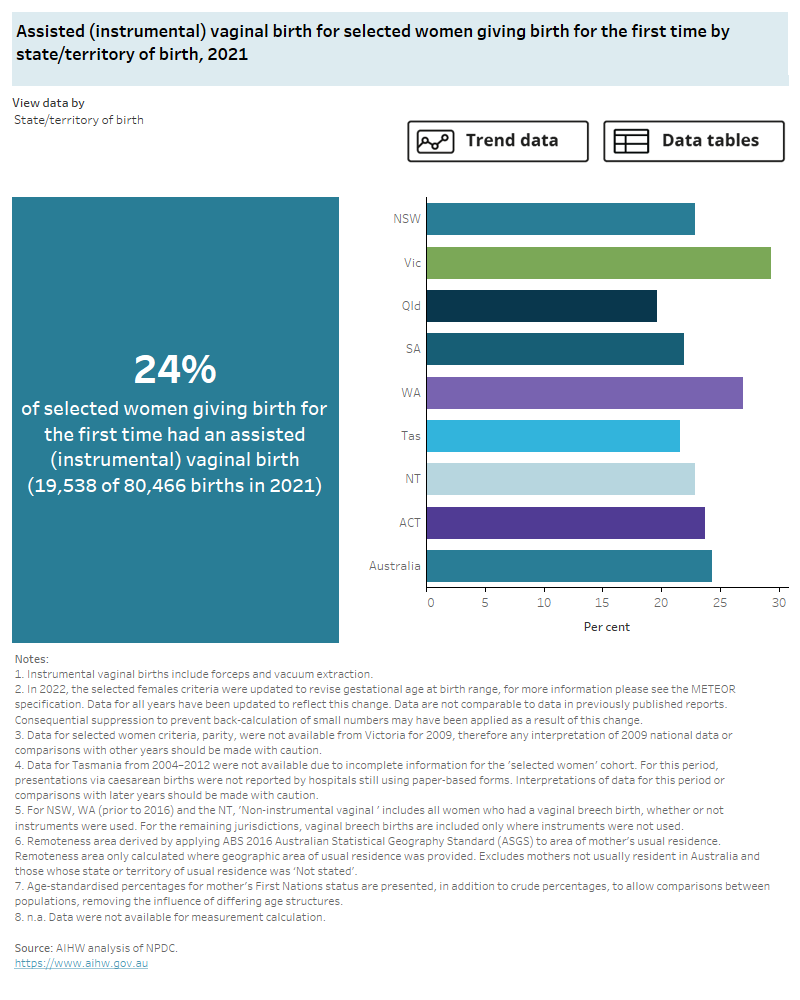Instrumental vaginal birth
The use of instruments – vacuum extraction cup or forceps – may be required to achieve a safe vaginal birth. Using instruments to assist birth is usually recommended when the condition of either the baby or the mother requires a hastened delivery (RANZCOG 2020). For more information, see Clinical commentary.
This indicator looks at instrumental vaginal births for selected women giving birth for the first time.
Key findings
In 2021, around 1 in 4 (24%) selected women giving birth for the first time had an instrumental vaginal birth.
The proportion of selected women giving birth for the first time having an instrumental vaginal birth:
- increased slightly from 2004 (23%) to 2021 (24%)
- was highest for women living in Major cities (25%) compared with other remoteness areas in 2021
- was slightly higher in private hospitals (25%) than public hospitals (24%), a difference that has been decreasing over time
- was higher for women living in areas of least disadvantage compared with women living in areas of most disadvantage (26% compared with 22% in 2021).
The interactive data visualisation (Figure 9) presents data on assisted (instrumental) vaginal birth for selected women giving birth for the first time by selected maternal characteristics. Select the trend button to see how data have changed between 2004 and 2021.
Figure 9: Instrumental vaginal birth
Assisted (Instrumental) vaginal birth for selected women giving birth for the first time, 2004 to 2021.
This chart shows the proportion of women having an assisted (instrumental) vaginal birth for selected women giving birth for the first time, for the current data 2021 and trend data from 2004 to 2021. The proportion of selected women having an assisted vaginal birth when giving birth for the first time increased from 23% in 2004 to 24% in 2021.

Clinical commentary
Instrumental delivery is employed to accelerate birth in the presence of suspected or anticipated fetal compromise, delay in the second stage of labour or when maternal pushing efforts may make blood pressure or heart problems worse (RANZCOG 2020). Both vacuum and forceps assisted delivery are associated with an increased risk of injury to the tissues of the vagina, perineum and anus. This may lead to long-term perineal pain and sexual difficulties; additionally, a very small number may have urinary or faecal incontinence (RANZCOG 2020; RCOG 2020). Specialist colleges of obstetrics and gynaecology recommend that episiotomy is used selectively, rather than routinely, in association with vacuum and forceps assistance to minimise that risk (RANZCOG 2020; RCOG 2020).
Although the overall rate of injury to the baby because of instrumental vaginal delivery is low, there is a risk of certain complications, including injuries to the baby’s scalp, head, and eyes; bleeding inside the skull; and problems with the nerves located in the arm and face (RCOG 2020). The choice of which instrument to use depends on the clinical situation, and the principles of informed consent require that the woman is provided with information regarding these risks and the proposed benefits of the procedure prior to embarking on assisted vaginal birth.
Indicator specifications and data
Excel source data tables are available from Data.
For more information refer to Specifications and notes for analysis in the technical notes.
RANZCOG (The Royal Australian and New Zealand College of Obstetricians and Gynaecologists) (2020) Obstetrics Intrapartum care, labour and birth: Instrumental vaginal birth (C-Obs 16), accessed 6 October 2021.
RCOG (The Royal College of Obstetricians and Gynaecologists) (2020) Green-top Guidelines: Assisted Vaginal Birth (Green-top Guideline No. 26), accessed 19 August 2022.


